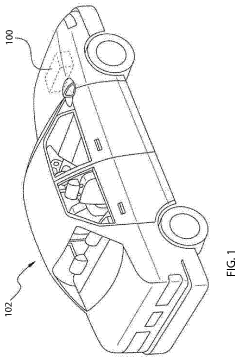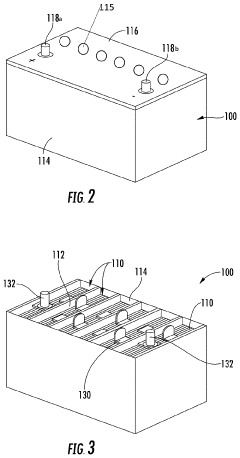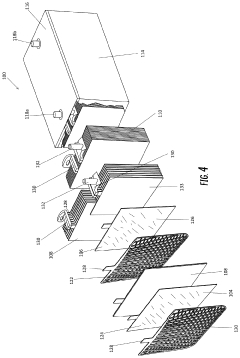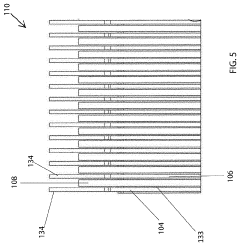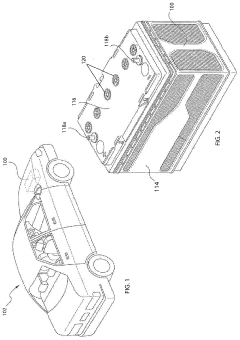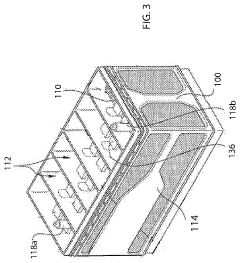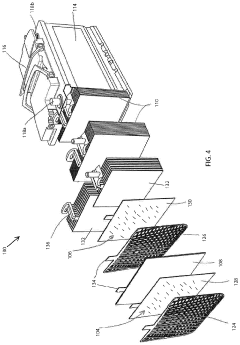Enhancing Energy Accessibility in Rural Areas with AGM Battery
AUG 8, 20259 MIN READ
Generate Your Research Report Instantly with AI Agent
Patsnap Eureka helps you evaluate technical feasibility & market potential.
AGM Battery Evolution and Rural Energy Goals
The evolution of Absorbent Glass Mat (AGM) battery technology has been closely intertwined with the goal of enhancing energy accessibility in rural areas. AGM batteries, first developed in the 1980s, have undergone significant improvements over the past four decades, making them increasingly suitable for off-grid and remote energy storage applications.
Initially designed for military and aircraft use, AGM batteries quickly found their way into various industries due to their superior performance characteristics. The technology's evolution has been driven by the need for more efficient, durable, and cost-effective energy storage solutions, particularly in areas with limited access to traditional power grids.
In the context of rural energy goals, AGM batteries have emerged as a promising solution to address the challenges of energy accessibility. Their ability to provide reliable power storage, coupled with low maintenance requirements and improved safety features, aligns well with the unique needs of rural communities. The evolution of AGM technology has focused on enhancing these key attributes to better serve remote areas.
One of the primary objectives in AGM battery development has been to increase energy density and cycle life. This has resulted in batteries that can store more energy in a smaller footprint and withstand a higher number of charge-discharge cycles, making them more suitable for long-term use in rural settings. Additionally, improvements in manufacturing processes have led to reduced costs, making AGM batteries more accessible to communities with limited financial resources.
The integration of AGM batteries with renewable energy sources, particularly solar and wind power, has been a significant milestone in rural energy accessibility. This combination has enabled the creation of reliable off-grid power systems, providing electricity to areas previously underserved by traditional infrastructure. The evolution of AGM technology has thus played a crucial role in supporting sustainable rural electrification initiatives worldwide.
Recent advancements in AGM battery technology have also focused on enhancing their performance in extreme environmental conditions, a critical factor for rural applications. Improved temperature resistance and better sealing techniques have made these batteries more resilient to harsh weather, dust, and humidity, ensuring consistent performance in diverse rural settings.
Looking ahead, the continued evolution of AGM batteries is expected to further align with rural energy goals. Research and development efforts are concentrating on increasing the batteries' lifespan, improving their recycling potential, and exploring new materials to enhance overall performance. These advancements aim to make AGM batteries an even more sustainable and cost-effective solution for rural energy needs, contributing to the broader goal of universal energy access.
Initially designed for military and aircraft use, AGM batteries quickly found their way into various industries due to their superior performance characteristics. The technology's evolution has been driven by the need for more efficient, durable, and cost-effective energy storage solutions, particularly in areas with limited access to traditional power grids.
In the context of rural energy goals, AGM batteries have emerged as a promising solution to address the challenges of energy accessibility. Their ability to provide reliable power storage, coupled with low maintenance requirements and improved safety features, aligns well with the unique needs of rural communities. The evolution of AGM technology has focused on enhancing these key attributes to better serve remote areas.
One of the primary objectives in AGM battery development has been to increase energy density and cycle life. This has resulted in batteries that can store more energy in a smaller footprint and withstand a higher number of charge-discharge cycles, making them more suitable for long-term use in rural settings. Additionally, improvements in manufacturing processes have led to reduced costs, making AGM batteries more accessible to communities with limited financial resources.
The integration of AGM batteries with renewable energy sources, particularly solar and wind power, has been a significant milestone in rural energy accessibility. This combination has enabled the creation of reliable off-grid power systems, providing electricity to areas previously underserved by traditional infrastructure. The evolution of AGM technology has thus played a crucial role in supporting sustainable rural electrification initiatives worldwide.
Recent advancements in AGM battery technology have also focused on enhancing their performance in extreme environmental conditions, a critical factor for rural applications. Improved temperature resistance and better sealing techniques have made these batteries more resilient to harsh weather, dust, and humidity, ensuring consistent performance in diverse rural settings.
Looking ahead, the continued evolution of AGM batteries is expected to further align with rural energy goals. Research and development efforts are concentrating on increasing the batteries' lifespan, improving their recycling potential, and exploring new materials to enhance overall performance. These advancements aim to make AGM batteries an even more sustainable and cost-effective solution for rural energy needs, contributing to the broader goal of universal energy access.
Rural Energy Demand Analysis
The demand for energy in rural areas has been steadily increasing due to various factors, including population growth, economic development, and the rising adoption of modern technologies. In many developing countries, rural communities face significant challenges in accessing reliable and affordable energy sources, which hinders their socio-economic progress and quality of life.
Rural energy demand primarily stems from household needs, agricultural activities, and small-scale industries. Households require energy for lighting, cooking, heating, and powering electronic devices. The agricultural sector demands energy for irrigation, crop processing, and storage facilities. Small-scale industries in rural areas also contribute to the growing energy demand as they seek to improve productivity and expand operations.
One of the key drivers of rural energy demand is the aspiration for improved living standards. As rural communities become more aware of modern amenities and technologies, there is a growing desire for access to electricity-powered appliances, entertainment devices, and communication tools. This shift in lifestyle expectations has led to a substantial increase in per capita energy consumption in rural areas.
The agricultural sector plays a crucial role in rural energy demand analysis. Modernization of farming practices, including the use of electric pumps for irrigation, mechanized equipment for planting and harvesting, and cold storage facilities for perishable goods, has significantly increased the energy requirements in rural agricultural settings. Additionally, the growing trend of agro-processing industries in rural areas further amplifies the energy demand.
Seasonal variations also impact rural energy demand patterns. During peak agricultural seasons, energy consumption tends to spike due to increased irrigation needs and the operation of processing equipment. Conversely, off-peak seasons may see a reduction in energy demand from the agricultural sector but could experience increased household consumption due to factors such as heating or cooling requirements.
The lack of reliable grid connectivity in many rural areas has led to a growing interest in decentralized energy solutions. This has created a unique demand for off-grid and mini-grid systems, often powered by renewable sources such as solar, wind, or small-scale hydropower. The adoption of these alternative energy solutions is reshaping the rural energy landscape and influencing demand patterns.
Understanding the rural energy demand is crucial for developing effective strategies to enhance energy accessibility. It requires a comprehensive analysis of various factors, including population demographics, economic activities, seasonal variations, and technological adoption rates. This analysis helps in designing appropriate energy solutions, such as AGM batteries, that can effectively meet the diverse and evolving energy needs of rural communities.
Rural energy demand primarily stems from household needs, agricultural activities, and small-scale industries. Households require energy for lighting, cooking, heating, and powering electronic devices. The agricultural sector demands energy for irrigation, crop processing, and storage facilities. Small-scale industries in rural areas also contribute to the growing energy demand as they seek to improve productivity and expand operations.
One of the key drivers of rural energy demand is the aspiration for improved living standards. As rural communities become more aware of modern amenities and technologies, there is a growing desire for access to electricity-powered appliances, entertainment devices, and communication tools. This shift in lifestyle expectations has led to a substantial increase in per capita energy consumption in rural areas.
The agricultural sector plays a crucial role in rural energy demand analysis. Modernization of farming practices, including the use of electric pumps for irrigation, mechanized equipment for planting and harvesting, and cold storage facilities for perishable goods, has significantly increased the energy requirements in rural agricultural settings. Additionally, the growing trend of agro-processing industries in rural areas further amplifies the energy demand.
Seasonal variations also impact rural energy demand patterns. During peak agricultural seasons, energy consumption tends to spike due to increased irrigation needs and the operation of processing equipment. Conversely, off-peak seasons may see a reduction in energy demand from the agricultural sector but could experience increased household consumption due to factors such as heating or cooling requirements.
The lack of reliable grid connectivity in many rural areas has led to a growing interest in decentralized energy solutions. This has created a unique demand for off-grid and mini-grid systems, often powered by renewable sources such as solar, wind, or small-scale hydropower. The adoption of these alternative energy solutions is reshaping the rural energy landscape and influencing demand patterns.
Understanding the rural energy demand is crucial for developing effective strategies to enhance energy accessibility. It requires a comprehensive analysis of various factors, including population demographics, economic activities, seasonal variations, and technological adoption rates. This analysis helps in designing appropriate energy solutions, such as AGM batteries, that can effectively meet the diverse and evolving energy needs of rural communities.
AGM Battery Technology: Current State and Challenges
AGM (Absorbent Glass Mat) battery technology has made significant strides in recent years, particularly in its application for enhancing energy accessibility in rural areas. The current state of AGM battery technology is characterized by its robust design, maintenance-free operation, and improved energy density compared to traditional lead-acid batteries.
One of the primary advantages of AGM batteries is their ability to provide reliable power in harsh environments, making them ideal for rural applications. These batteries feature a sealed design that prevents electrolyte leakage and allows for flexible mounting orientations, crucial for installations in remote locations with limited infrastructure.
Despite these advancements, AGM battery technology faces several challenges in rural energy applications. One significant hurdle is the relatively high initial cost compared to conventional lead-acid batteries. This cost factor can be a barrier to adoption in economically disadvantaged rural areas, where affordability is a key consideration.
Another challenge is the limited cycle life of AGM batteries, especially when subjected to deep discharge cycles, which are common in off-grid rural energy systems. While AGM batteries generally outperform flooded lead-acid batteries in this aspect, they still fall short of the longevity offered by more advanced lithium-ion technologies.
Temperature sensitivity remains a concern for AGM batteries, particularly in rural areas with extreme climates. High temperatures can accelerate battery degradation, while low temperatures can significantly reduce capacity and performance. This necessitates careful system design and potentially additional thermal management solutions in rural installations.
The charging infrastructure for AGM batteries in rural areas poses another challenge. These batteries require specific charging profiles to maximize their lifespan and efficiency. Implementing and maintaining appropriate charging systems in remote locations can be technically and logistically challenging.
Recycling and end-of-life management of AGM batteries in rural areas is an emerging concern. While the batteries are recyclable, the lack of proper recycling facilities in many rural regions can lead to environmental issues if not addressed adequately.
Despite these challenges, ongoing research and development efforts are focused on improving AGM battery technology. These include enhancing the energy density, extending cycle life, and developing more temperature-resistant formulations. Additionally, efforts are being made to reduce manufacturing costs to make AGM batteries more accessible for rural energy applications.
One of the primary advantages of AGM batteries is their ability to provide reliable power in harsh environments, making them ideal for rural applications. These batteries feature a sealed design that prevents electrolyte leakage and allows for flexible mounting orientations, crucial for installations in remote locations with limited infrastructure.
Despite these advancements, AGM battery technology faces several challenges in rural energy applications. One significant hurdle is the relatively high initial cost compared to conventional lead-acid batteries. This cost factor can be a barrier to adoption in economically disadvantaged rural areas, where affordability is a key consideration.
Another challenge is the limited cycle life of AGM batteries, especially when subjected to deep discharge cycles, which are common in off-grid rural energy systems. While AGM batteries generally outperform flooded lead-acid batteries in this aspect, they still fall short of the longevity offered by more advanced lithium-ion technologies.
Temperature sensitivity remains a concern for AGM batteries, particularly in rural areas with extreme climates. High temperatures can accelerate battery degradation, while low temperatures can significantly reduce capacity and performance. This necessitates careful system design and potentially additional thermal management solutions in rural installations.
The charging infrastructure for AGM batteries in rural areas poses another challenge. These batteries require specific charging profiles to maximize their lifespan and efficiency. Implementing and maintaining appropriate charging systems in remote locations can be technically and logistically challenging.
Recycling and end-of-life management of AGM batteries in rural areas is an emerging concern. While the batteries are recyclable, the lack of proper recycling facilities in many rural regions can lead to environmental issues if not addressed adequately.
Despite these challenges, ongoing research and development efforts are focused on improving AGM battery technology. These include enhancing the energy density, extending cycle life, and developing more temperature-resistant formulations. Additionally, efforts are being made to reduce manufacturing costs to make AGM batteries more accessible for rural energy applications.
Existing AGM Battery Solutions for Rural Areas
01 AGM battery structure and design improvements
Advancements in AGM battery structure and design focus on enhancing energy accessibility. This includes optimizing electrode configurations, improving electrolyte distribution, and developing novel separator materials. These innovations aim to increase the battery's overall performance, charge acceptance, and energy output.- AGM battery structure and design improvements: Advancements in AGM battery structure and design focus on enhancing energy accessibility. This includes optimizing electrode configurations, improving separator materials, and refining internal cell architecture to facilitate better electrolyte distribution and ion movement. These improvements aim to increase the battery's overall efficiency and power output.
- Electrolyte management and distribution systems: Innovative electrolyte management and distribution systems are developed to improve AGM battery energy accessibility. These systems ensure optimal electrolyte saturation throughout the battery, preventing dry spots and enhancing overall performance. Advanced wicking materials and channeling designs are employed to maintain consistent electrolyte distribution during charge and discharge cycles.
- Thermal management solutions: Thermal management solutions are implemented to maintain optimal operating temperatures for AGM batteries, thereby improving energy accessibility. These solutions include advanced cooling systems, heat dissipation materials, and temperature-controlled environments. By regulating battery temperature, these innovations help prevent performance degradation and extend battery life.
- Smart charging and monitoring systems: Integration of smart charging and monitoring systems enhances AGM battery energy accessibility. These systems utilize advanced algorithms and sensors to optimize charging processes, monitor battery health, and predict maintenance needs. By ensuring efficient charging and preventing overcharging or deep discharging, these innovations maximize battery performance and longevity.
- Enhanced grid and plate designs: Improved grid and plate designs are developed to increase AGM battery energy accessibility. These advancements focus on optimizing the surface area and structure of battery plates, enhancing current collection efficiency, and reducing internal resistance. Novel materials and manufacturing techniques are employed to create more durable and efficient battery components.
02 Battery management systems for AGM batteries
Implementing sophisticated battery management systems can significantly improve AGM battery energy accessibility. These systems monitor and control various parameters such as voltage, current, and temperature, optimizing charging and discharging processes. This leads to enhanced battery life, improved energy efficiency, and better overall performance.Expand Specific Solutions03 Thermal management techniques for AGM batteries
Effective thermal management is crucial for maintaining optimal AGM battery performance and energy accessibility. This includes developing cooling systems, heat dissipation methods, and temperature control mechanisms. These techniques help prevent overheating, extend battery life, and ensure consistent energy output across various operating conditions.Expand Specific Solutions04 Charging strategies for improved energy accessibility
Advanced charging strategies are being developed to enhance AGM battery energy accessibility. These include pulse charging techniques, multi-stage charging algorithms, and adaptive charging methods. Such approaches aim to reduce charging times, increase charge acceptance, and improve overall energy efficiency of AGM batteries.Expand Specific Solutions05 Integration of AGM batteries in energy storage systems
Optimizing the integration of AGM batteries in larger energy storage systems can improve overall energy accessibility. This involves developing intelligent control systems, load balancing techniques, and efficient power conversion methods. Such integration strategies enhance the reliability and performance of AGM batteries in various applications, from renewable energy storage to backup power systems.Expand Specific Solutions
Key Players in AGM Battery and Rural Energy Sectors
The AGM battery market for enhancing energy accessibility in rural areas is in a growth phase, driven by increasing demand for reliable off-grid power solutions. The market size is expanding, with significant potential in developing regions. Technologically, AGM batteries are relatively mature, offering improved performance over traditional lead-acid batteries. Key players like Fengfan Co., Ltd., Tianneng Battery Group, and Camel Group are advancing the technology, focusing on durability, efficiency, and cost-effectiveness. Companies such as BoxPower, Inc. and Inergy Holdings LLC are integrating AGM batteries into comprehensive rural electrification solutions, demonstrating the technology's practical applications and market readiness.
Fengfan Co., Ltd.
Technical Solution: Fengfan has developed a series of AGM batteries tailored for rural energy applications, focusing on durability and efficiency. Their AGM technology utilizes a unique plate design that increases the surface area for improved charge acceptance and faster recharge rates. Fengfan's batteries incorporate a special alloy composition that enhances corrosion resistance, crucial for the harsh environments often found in rural areas. The company has also implemented advanced manufacturing processes to ensure consistent quality and performance across their AGM battery range. Fengfan's AGM batteries feature a low internal resistance design, which allows for higher discharge currents and better performance in high-load applications often required in rural energy systems[2][4].
Strengths: High discharge current capability, improved corrosion resistance, and consistent performance. Weaknesses: Potentially higher weight compared to some competitors, and limited flexibility in terms of form factors.
Tianneng Battery Group Co., Ltd.
Technical Solution: Tianneng has developed advanced AGM (Absorbent Glass Mat) batteries specifically designed for rural energy applications. Their technology incorporates high-purity lead alloys and precision-engineered separators to enhance charge acceptance and cycle life. The company's AGM batteries feature a proprietary valve-regulated design that minimizes water loss and allows for maintenance-free operation, crucial for remote installations. Tianneng's batteries also incorporate advanced carbon additives in the negative plates, which significantly improve charge acceptance and reduce sulfation, leading to extended battery life in partial state of charge conditions often encountered in rural off-grid systems[1][3].
Strengths: Long cycle life, maintenance-free operation, and improved performance in partial state of charge conditions. Weaknesses: Higher initial cost compared to flooded lead-acid batteries, and potential sensitivity to high-temperature environments.
Core Innovations in AGM Battery Technology
Compact absorbent glass mat battery
PatentPendingUS20200212504A1
Innovation
- A compact AGM lead acid battery design with a reduced lead content and smaller size, utilizing a container with electrically connected cells and an absorbent glass mat interleaved between positive and negative plates, achieving improved cycle life and higher CCA performance.
Absorbent glass mat battery
PatentPendingUS20240222600A1
Innovation
- The development of a lead-acid battery with a negative electrode comprising a leady oxide, a synthetic organic expander, conductive carbons, and very fine particle barium sulfate, along with an absorbent glass mat separator, which enhances charge acceptance and cycling performance by improving the electrochemical active material composition and structure.
Environmental Impact of AGM Batteries in Rural Settings
The environmental impact of AGM (Absorbent Glass Mat) batteries in rural settings is a crucial consideration when enhancing energy accessibility in these areas. AGM batteries offer several environmental advantages compared to traditional lead-acid batteries, making them a more sustainable choice for rural electrification projects.
One of the primary environmental benefits of AGM batteries is their sealed design, which significantly reduces the risk of electrolyte leakage. This feature is particularly important in rural areas where proper disposal facilities may be limited. The sealed construction prevents harmful chemicals from contaminating soil and water sources, protecting local ecosystems and human health.
AGM batteries also have a longer lifespan compared to conventional lead-acid batteries, typically lasting up to 10 years with proper maintenance. This extended service life reduces the frequency of battery replacements, thereby minimizing waste generation and the associated environmental impact of manufacturing and transporting new batteries to remote rural locations.
The improved charge efficiency of AGM batteries contributes to their environmental friendliness. They can be charged more quickly and efficiently than traditional lead-acid batteries, resulting in reduced energy consumption during the charging process. This efficiency translates to lower overall energy requirements and, consequently, a smaller carbon footprint for rural energy systems.
In terms of recyclability, AGM batteries are highly recyclable, with up to 99% of their components being recoverable. The lead, plastic, and other materials can be reclaimed and reused in the production of new batteries or other products. This closed-loop recycling process helps conserve natural resources and reduces the environmental impact associated with raw material extraction and processing.
AGM batteries also perform well in extreme temperatures, which is particularly beneficial in rural areas with varying climatic conditions. Their ability to function efficiently in both hot and cold environments reduces the need for energy-intensive climate control systems, further lowering the overall environmental impact of rural energy installations.
The maintenance-free nature of AGM batteries is another environmental advantage. Unlike flooded lead-acid batteries, AGM batteries do not require regular water additions or equalization charges. This reduces the risk of improper maintenance leading to premature battery failure and subsequent environmental disposal issues.
However, it is important to note that the production of AGM batteries still involves the use of lead and other potentially harmful materials. While the manufacturing process has become more environmentally friendly over the years, proper end-of-life management remains crucial to minimize negative environmental impacts.
In conclusion, the use of AGM batteries in rural energy systems offers significant environmental benefits, including reduced risk of contamination, longer lifespan, improved energy efficiency, high recyclability, and lower maintenance requirements. These advantages make AGM batteries a more sustainable choice for enhancing energy accessibility in rural areas, contributing to both improved quality of life and environmental protection.
One of the primary environmental benefits of AGM batteries is their sealed design, which significantly reduces the risk of electrolyte leakage. This feature is particularly important in rural areas where proper disposal facilities may be limited. The sealed construction prevents harmful chemicals from contaminating soil and water sources, protecting local ecosystems and human health.
AGM batteries also have a longer lifespan compared to conventional lead-acid batteries, typically lasting up to 10 years with proper maintenance. This extended service life reduces the frequency of battery replacements, thereby minimizing waste generation and the associated environmental impact of manufacturing and transporting new batteries to remote rural locations.
The improved charge efficiency of AGM batteries contributes to their environmental friendliness. They can be charged more quickly and efficiently than traditional lead-acid batteries, resulting in reduced energy consumption during the charging process. This efficiency translates to lower overall energy requirements and, consequently, a smaller carbon footprint for rural energy systems.
In terms of recyclability, AGM batteries are highly recyclable, with up to 99% of their components being recoverable. The lead, plastic, and other materials can be reclaimed and reused in the production of new batteries or other products. This closed-loop recycling process helps conserve natural resources and reduces the environmental impact associated with raw material extraction and processing.
AGM batteries also perform well in extreme temperatures, which is particularly beneficial in rural areas with varying climatic conditions. Their ability to function efficiently in both hot and cold environments reduces the need for energy-intensive climate control systems, further lowering the overall environmental impact of rural energy installations.
The maintenance-free nature of AGM batteries is another environmental advantage. Unlike flooded lead-acid batteries, AGM batteries do not require regular water additions or equalization charges. This reduces the risk of improper maintenance leading to premature battery failure and subsequent environmental disposal issues.
However, it is important to note that the production of AGM batteries still involves the use of lead and other potentially harmful materials. While the manufacturing process has become more environmentally friendly over the years, proper end-of-life management remains crucial to minimize negative environmental impacts.
In conclusion, the use of AGM batteries in rural energy systems offers significant environmental benefits, including reduced risk of contamination, longer lifespan, improved energy efficiency, high recyclability, and lower maintenance requirements. These advantages make AGM batteries a more sustainable choice for enhancing energy accessibility in rural areas, contributing to both improved quality of life and environmental protection.
Policy Framework for Rural Energy Access
The policy framework for rural energy access plays a crucial role in enhancing energy accessibility in rural areas, particularly when considering the implementation of AGM battery technology. Governments and regulatory bodies must establish comprehensive policies that support the adoption of sustainable energy solutions in remote and underserved regions.
A key aspect of this framework is the development of clear guidelines for the deployment of AGM battery systems in rural areas. These guidelines should address technical specifications, safety standards, and installation requirements to ensure the effective and safe implementation of the technology. Additionally, policies should outline the responsibilities of various stakeholders, including local authorities, energy providers, and community organizations, in the planning and execution of rural energy projects.
Financial incentives are essential components of the policy framework. Governments should consider implementing subsidies, tax breaks, or low-interest loans to encourage investment in AGM battery systems for rural electrification. These incentives can help overcome the initial cost barriers associated with implementing new energy technologies in remote areas, making them more accessible to rural communities and private sector investors.
The framework should also incorporate capacity-building initiatives to support the long-term sustainability of rural energy projects. This includes policies that promote training programs for local technicians, educating communities on the benefits and proper use of AGM battery systems, and fostering the development of local businesses in the renewable energy sector.
Environmental considerations must be integrated into the policy framework. Regulations should address the proper disposal and recycling of AGM batteries at the end of their lifecycle, minimizing potential environmental impacts. Furthermore, policies should encourage the integration of AGM battery systems with other renewable energy sources, such as solar or wind power, to create more resilient and sustainable rural energy networks.
Monitoring and evaluation mechanisms are crucial for assessing the effectiveness of rural energy access policies. The framework should include provisions for regular data collection, performance tracking, and impact assessments of AGM battery implementations. This information can be used to refine policies, identify best practices, and inform future decision-making in rural electrification efforts.
Lastly, the policy framework should promote collaboration between different levels of government, international organizations, and the private sector. This multi-stakeholder approach can leverage diverse expertise and resources, leading to more innovative and effective solutions for enhancing energy accessibility in rural areas using AGM battery technology.
A key aspect of this framework is the development of clear guidelines for the deployment of AGM battery systems in rural areas. These guidelines should address technical specifications, safety standards, and installation requirements to ensure the effective and safe implementation of the technology. Additionally, policies should outline the responsibilities of various stakeholders, including local authorities, energy providers, and community organizations, in the planning and execution of rural energy projects.
Financial incentives are essential components of the policy framework. Governments should consider implementing subsidies, tax breaks, or low-interest loans to encourage investment in AGM battery systems for rural electrification. These incentives can help overcome the initial cost barriers associated with implementing new energy technologies in remote areas, making them more accessible to rural communities and private sector investors.
The framework should also incorporate capacity-building initiatives to support the long-term sustainability of rural energy projects. This includes policies that promote training programs for local technicians, educating communities on the benefits and proper use of AGM battery systems, and fostering the development of local businesses in the renewable energy sector.
Environmental considerations must be integrated into the policy framework. Regulations should address the proper disposal and recycling of AGM batteries at the end of their lifecycle, minimizing potential environmental impacts. Furthermore, policies should encourage the integration of AGM battery systems with other renewable energy sources, such as solar or wind power, to create more resilient and sustainable rural energy networks.
Monitoring and evaluation mechanisms are crucial for assessing the effectiveness of rural energy access policies. The framework should include provisions for regular data collection, performance tracking, and impact assessments of AGM battery implementations. This information can be used to refine policies, identify best practices, and inform future decision-making in rural electrification efforts.
Lastly, the policy framework should promote collaboration between different levels of government, international organizations, and the private sector. This multi-stakeholder approach can leverage diverse expertise and resources, leading to more innovative and effective solutions for enhancing energy accessibility in rural areas using AGM battery technology.
Unlock deeper insights with Patsnap Eureka Quick Research — get a full tech report to explore trends and direct your research. Try now!
Generate Your Research Report Instantly with AI Agent
Supercharge your innovation with Patsnap Eureka AI Agent Platform!
